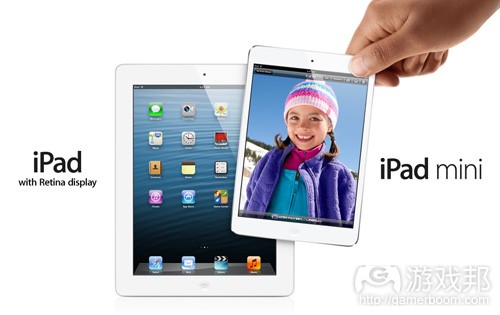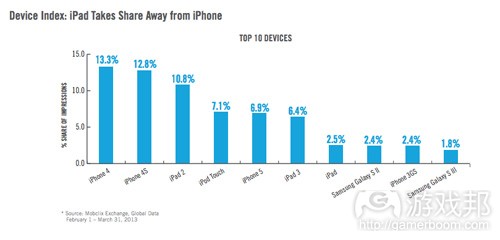每日观察:关注iOS和Android移动广告市场份额(4.20)
1)据pocketgamer报道,谷歌日前宣布支持开发者通过Google Play直接回复用户评论,其回复内容将向所有Google Play用户公开。
过去用户针对应用问题发布负面评价时,即使开发者已经修复问题,用户消极评价仍然存在,而开发者却无法作出解释。现在开发者将可用更公开的方式回应用户,让新老用户知晓旧问题已经得到解决。
2)YouGov第一季度调查结果显示,苹果iPad在苹果平板电脑市场份额下滑,从原来的73%跌至63%;而Android平板电脑市场份额却显著上升,例如三星平板电脑就从去年同期的4%增长至10%。
谷歌Nexus 7市场份额增长至8%,亚马逊Kindle Fire则从1%增长至5%。
YouGov调查指出超过18%的英国成人用户(800万)拥有平板电脑,这一比例比2012年第四季度增长了5%。
3)据venturebeat报道,休闲游戏公司PopCap日前向iOS平台发布新款免费增值游戏《Bookworm Heroes》,玩家在游戏中要从字母格中拼出单词,并打败竞争对手,其敌手或是AI或是其他玩家。
4)据Techcrunch报道,移动广告公司Velti最近报告显示,iPad在3月份Velti平台所有平板电脑广告印象中占比91.6%,iPad Mini占比6.2%;Kindle Fire占比1.6%。亚马逊和三星平板电脑在Android平板电脑中分别占比73.4%和26.2%。
从手机设备来看,iPhone仍然居首,iPhone 4所占广告份额为13.3%;三星设备则在所有Android手机广告印象中占比68.2%。
5)移动广告交易平台MoPub最近数据显示,2011年移动广告市场规模为14亿美元,2012年增长至41亿美元,预计2013年将增长至73亿美元。
每一美元的移动广告支出,就有75美分流向了iOS平台。Android智能手机CPM仅为0.5美元,iPhone CPM介于0.65至0.88美元,iPod Touch则是0.74至0.98美元,iPad则是0.82至1.16美元。
Android设备的广告点击率仅为iOS设备的一半左右,Android平板电脑广告点击率不足1%,Android智能手机广告点击率也仅超过1%;而iPhone点击率为1.4%-1.7%,iPad则高达2%-2.5%。(本文为游戏邦/gamerboom.com编译,拒绝任何不保留版权的转载,如需转载请联系:游戏邦)
1)Google Play now allows developers to reply to user reviews
by Keith Andrew
With no official announcement or fanfare to be found, it would appear Google now allows developers to directly reply to user reviews posted on Google Play.
Developers on Twitter are reporting that they’re now able to respond to posts made in review of their apps and games, with replies made public for Google Play’s entire userbase to see.
Talky talk
According to Josh Presseisen of Crescent Moon Games, Android developers have been told that their replies will be “publicly visible underneath the original review in the Google Play store.”
Google lets you reply to app reviews now. This is both good and bad. ![]()
— Josh Presseisen (@CM_Games) April 19, 2013
Presseisen says he believe the new feature was added last night, though he only found out after being tipped off by Laylio Games.
The move is not without precedent, however, coming little over a week after Google unveiled a new look and purchase flow for its official store.
About time?
Indeed, many developers have long called out for a way to interact with user reviews on all major mobile marketplaces, with the ability to respond to negative reviews in particular an
understandable aim.
The new look Google Play store
Even when an app is updated to fix any issues or quarrels highlight by said negative user reviews, on most marketplaces the review itself remains, with little evidence on the store itself
that the problems cited have been overcome.
Now, in theory, developers will be able to deal with complaints in a more open and public manner, engaging their audience and ensuring newcomers can see past issues have been dealt with.
(source:pocketgamer)
2)Apple’s UK tablet market share drops ten per cent
by Daniel Gumble
Android tablets cutting into Apple’s ownership.
While the iPad may still be able to lay claim to dominion over the UK tablet market, the growing popularity of Android tablets has led to a ten per cent dip in market share for Apple, according to YouGov’s Quarterly Tablet Tracker for Q1.
The report shows that Apple’s market share has fallen from 73 per cent to 63 per cent in the first quarter, despite the recent releases of it fourth generation iPad and iPad Mini.
Meanwhile, Samsung has more than doubled its market share, rising from four per cent in Q1 2012 to ten per cent in Q1 2013.
The arrival of two new devices on the scene has also contributed to Apple’s decline, with the Google Nexus 7 amassing a market share of eight per cent in under a year and the Amazon Kindle
Fire jumping to five per cent from just one per cent in the previous quarter.
YouGov’s Quarterly Tablet Tracker also revealed that over 18 per cent of the UK adult population – that’s more than eight million adults – now own a tablet device, marking an increase of
five per cent since Q4 2012.
John Gilbert, Consulting director of YouGov Technology and Telecoms, commented: “With a growing market, greater competition and falling prices, Apple was bound to lose some share.
However, it is not simply a matter of inexpensive products flooding the market. It seems that Apple no longer has a monopoly on the “premium” share as other brands emerge with near-equal
satisfaction scores. Given the market’s current expectations and considerations in purchasing tablets, we anticipate Apple to lose additional share throughout the coming year to Samsung,
Google and Amazon.”(source:mobile-ent)
3)PopCap releases Bookworm Heroes for iOS
Jeffrey Grubb
One of the biggest names in word games is back with an updated take on a classic franchise.
PopCap released Bookworm Heroes for iOS devices today. The developer, a subsidiary of publisher Electronic Arts, worked to add social features and fighting game-style mechanics. Heroes has players spelling out words from a grid of letters while attempting to defeat opponents. Enemies are either computer A.I. or other players.
The title is free to play. You can beef up abilities with in-game purchases.
“We’re ecstatic to introduce the next chapter of Bookworm to iOS users in a new adaptation that brings multiplayer and social gameplay to what’s previously been a solitary player
experience,” Bookworm franchise director Scott Willoughby said in a statement. “Bookworm Heroes adds a new level of fun and challenge among friends, plus a ton of extras that we believe
make this the best Bookworm iteration yet.”(source:venturebeat)
4)iPad Still Dominates Tablet Ads With iPad Mini Gaining, Velti Finds
Darrell Etherington
Mobile advertising firm Velti has released its monthly report on advertising impressions across its network. The iPad is far and away the leader when it comes to the tablet market, and is
gradually chipping away share from the iPhone in terms of overall dominance among mobile ads. The iPad mini remains a much smaller factor, but is growing steadily, and on the Android side
it’s pretty much all about the Kindle Fire.
Velti’s data found that the iPad accounted for 91.6 percent of all tablet ad impression during the month of March, and only lost share to the iPad mini, which gained a full percentage point to come in at 6.2 percent during the month, firmly in second place. The Kindle Fire was the next strongest device, with a comparatively small piece of the pie at 1.6 percent. The Kindle Fire still dominates the Android tablet segment, however, with only the Galaxy Tab line of devices anywhere close. Amazon’s and Samsung’s tablets made up 73.4 percent and 26.2 percent of all Android tablet share, respectively.
Among phones, the iPhone still leads the pack, with the iPhone 4 still leading all handsets with 13.3 percent of the impression share. iPhones accounted for eight of the top 10 devices,
with the Samsung Galaxy S II and S III coming in at 8th and 10th place, respectively. Samsung is running away with the Android market in terms of ads served according to Velti’s figures,
with 68.2 percent of all Android impressions. That’s no surprise given the company’s clear continued dominance in terms of hardware sales.(source:techcrunch)
5)Why 75 cents of every dollar spent on mobile advertising is spent on iPhone and iPad
John Koetsier
San Francisco, CA Early Bird Tickets on Sale The booming mobile advertising market grew from $1.4 billion in 2011 to $4.1 billion in 2012, and it’s projected to hit a massive $7.3 billion in 2013.
And almost all of it is spent on Apple’s ecosystem.
There’s a reason that even though Android has almost caught up to iOS in downloads, it’s still way behind in monetization. Partially, it’s because iTunes has a long and successful history of commercial transactions, so people feel comfortable clicking and shopping and buying on iOS. Partially, it’s because Apple was the leader in mobile for so long.
But it’s also because advertisers are simply getting fed up with an Android ecosystem that doesn’t convert very well.
Mobile ad spend ballooned in March 2013
“There have been whispers and comments around Google’s Play app store, and some of those concerns were supported when they announced a redesign,” Paul Gelb, head of strategy for MoPub, the world’s largest mobile ad exchange says. “If you have people click on your ad and drive them to the app store and that becomes a breakage point … that will reduce the value of the ad that you want to buy.”
Which is a nice way of saying that ads for app installs aren’t always working, even when the mobile user taps on your ad.
Most advertisers and ad exchange partners don’t want to talk on the record, of course. But off the record, they’ll say that Google Play is just not at the quality level of the iOS app ecosystem. There’s too much crap, too much malware, there’s not the level of quality that iOS has … and there is a missing mass of people on the platform who have confirmed credit card accounts and are, frankly, in the demographic who are willing and able to buy.
That may sound sacrilegious to Android enthusiasts, many of whom are tech-savvy and higher-income, but it’s borne out by the numbers.
Not only are 75 cents out of every mobile ad dollar spent on iOS, but iPhone, iPad, and yes, even iPod touch ad rates are much higher. While Android smartphones draw $.50 CPMs (cost per thousand impressions), iPhones pull in $.65 to $.88 CPMs, iPod Touches do $.74 to $.98, and iPads do between $.82 and $1.16.
Mobile ad CPMs for the first quarter of 2013
So while tablets are the highest-revenue mobile ad platforms, Android tablets only account for a skinny single percent of all mobile ad sales.
That’s entirely due to the basic question underlying ad pricing: Do they work? Click-through rates on Android devices are about half as good as those on iOS devices, with under one percent on Android tablets and just over a percent on Android smartphones. Meanwhile, iOS devices such as iPads pull in 2-2.5 percent click-through rates, and iPhone pulls in 1.4-1.7 percent.(source:venturebeat)














































